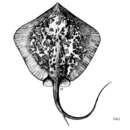fr
noms dans le fil d’Ariane


Dasyatis marmorata és una espècie de peix de la família dels dasiàtids i de l'ordre dels myliobatiformes present a l'Oceà Atlàntic oriental i la Mediterrània: des del Marroc i Mauritània fins a la República del Congo i Sud-àfrica (KwaZulu-Natal).[5] És un peix marí demersal de clima tropical, que viu entre 12–65 m de fondària.[5][6] Els mascles poden assolir 60 cm de longitud total.[5][6] És ovovivípar.[7] Menja crancs, amfípodes, cucs, peixos i Stomatopoda.[8] Pot causar lesions doloroses als humans.[9]
Dasyatis marmorata és una espècie de peix de la família dels dasiàtids i de l'ordre dels myliobatiformes present a l'Oceà Atlàntic oriental i la Mediterrània: des del Marroc i Mauritània fins a la República del Congo i Sud-àfrica (KwaZulu-Natal). És un peix marí demersal de clima tropical, que viu entre 12–65 m de fondària. Els mascles poden assolir 60 cm de longitud total. És ovovivípar. Menja crancs, amfípodes, cucs, peixos i Stomatopoda. Pot causar lesions doloroses als humans.
Dasyatis marmorata, the marbled stingray, is a species of stingray of the family Dasyatidae. Its geographic range covers the central and south-eastern Atlantic, from Morocco to South Africa.[1] It is also present in the coastal waters of southern Mediterranean Sea and the Levantine Basin.[2][3] This bottom-dweller generally inhabits sandy or muddy flats near rocky reefs and kelp forests, to a depth of 50 m (164 ft).
{{cite web}}: External link in |title=Dasyatis marmorata, the marbled stingray, is a species of stingray of the family Dasyatidae. Its geographic range covers the central and south-eastern Atlantic, from Morocco to South Africa. It is also present in the coastal waters of southern Mediterranean Sea and the Levantine Basin. This bottom-dweller generally inhabits sandy or muddy flats near rocky reefs and kelp forests, to a depth of 50 m (164 ft).
Dasyatis marmorata es una especie de pez de la familia Dasyatidae en el orden de los Rajiformes.
• Los machos pueden llegar alcanzar los 60 cm de longitud total.[1][2]
Es ovíparo.
Come cangrejos, anfípodos, gusanos, peces hueso y Stomatopoda .
Es un pez de mar y de clima tropical y demersal que vive entre 12-65 m de profundidad.
Se encuentra en el Océano Atlántico oriental y el Mediterráneo: desde Marruecos y Mauritania hasta el Congo y Sudáfrica (KwaZulu-Natal ).
Puede causar lesiones dolorosas en los humanos.
Dasyatis marmorata es una especie de pez de la familia Dasyatidae en el orden de los Rajiformes.
Dasyatis marmorata Dasyatis generoko animalia da. Arrainen barruko Dasyatidae familian sailkatzen da.
Dasyatis marmorata Dasyatis generoko animalia da. Arrainen barruko Dasyatidae familian sailkatzen da.
Dasyatis marmorata is een vissensoort uit de familie van de pijlstaartroggen (Dasyatidae).[1] De wetenschappelijke naam van de soort is voor het eerst geldig gepubliceerd in 1892 door Steindachner.
Bronnen, noten en/of referentiesDasyatis marmorata Steindachner, 1892
СинонимыDasyatis marmorata (лат.) — вид рода хвостоколов из семейства хвостоко́ловых отряда хвостоколообразных надотряда скатов. Они обитают в тропических водах Восточной Атлантики, включая Средиземное море. Встречаются на глубине до 65 м. Максимальная зарегистрированная длина 60 см. Грудные плавники этих скатов срастаются с головой, образуя ромбовидный диск. Рыло заострённое. Хвост длиннее диска. Дорсальная поверхность диска покрыта голубыми рваными пятнами. Позади шипа на хвостовом стебле расположены вентральная и каудальная кожные складки. Подобно прочим хвостоколообразным Dasyatis marmorata размножаются яйцеживорождением. Эмбрионы развиваются в утробе матери, питаясь желтком и гистотрофом. Не являются объектом целевого промысла. В качестве прилова попадаются при донном тралении[1][2].
Впервые Dasyatis marmorata был научно описан в 1892 году[3]. Неотип представляет собой взрослого самца длиной с диском шириной 27,4 см, пойманного в районе между реками Сенегал и Гамбия[4]. Ранее этот вид путали с морским котом и Dasyatis chrysonota. Для прояснения таксономического статуса необходимы дальнейшие исследования. Также необходимо критическое сравнение особей Dasyatis marmorata, принадлежащих к средиземноморской и восточно-атлантической популяциям[2].
Dasyatis marmorata обитают в восточной части Атлантического океана и в Средиземном море. Эти скаты встречаются в прибрежных водах на континентальном шельфе на глубине от 12 до 65 м. Они держатся на песчаном дне в мелких бухтах или со скалистыми рифами. Зимой они перемещаются на глубину[5]. Подобно большинству хвостоколов они ведут донный образ жизни[2].
Грудные плавники этих скатов срастаются с головой, образуя округлый плоский диск. Рыло заострённое. Позади глаз имеются брызгальца. На вентральной поверхности диска расположены 5 жаберных щелей, рот и ноздри. Между ноздрями пролегает лоскут кожи с бахромчатым нижним краем. Зубы выстроены в шахматном порядке и образуют плоскую поверхность. Хвост в виде кнута менее чем в 2 раза длиннее диска. Как и у других хвостоколов на дорсальной поверхности в центральной части хвостового стебля расположен зазубренный шип, соединённый протоками с ядовитой железой. Периодически шип обламывается и на его месте вырастает новый. Позади шипа на хвостовом стебле расположены короткая дорсальная и удлинённая вентральная кожные складки. Окраска дорсальной поверхности диска золотисто-коричневого цвета с многочисленными голубыми пятнами. Кожа лишена чешуи. Максимальная зарегистрированная ширина диска 60 см[6][7].
Подобно прочим хвостоколообразным Dasyatis marmorata относится к яйцеживородящим рыбам. Эмбрионы развиваются в утробе матери, питаясь желтком и гистотрофом. В помёте 1—4 новорожденных[5]. Рацион состоит из костистых рыб и донных беспозвоночных.
Dasyatis marmorata не являются объектом целевого лова. Попадаются в качестве прилова при коммерческом промысле путём донного траления. Данных для оценки Международным союзом охраны природы статуса сохранности вида недостаточно[2].
Dasyatis marmorata (лат.) — вид рода хвостоколов из семейства хвостоко́ловых отряда хвостоколообразных надотряда скатов. Они обитают в тропических водах Восточной Атлантики, включая Средиземное море. Встречаются на глубине до 65 м. Максимальная зарегистрированная длина 60 см. Грудные плавники этих скатов срастаются с головой, образуя ромбовидный диск. Рыло заострённое. Хвост длиннее диска. Дорсальная поверхность диска покрыта голубыми рваными пятнами. Позади шипа на хвостовом стебле расположены вентральная и каудальная кожные складки. Подобно прочим хвостоколообразным Dasyatis marmorata размножаются яйцеживорождением. Эмбрионы развиваются в утробе матери, питаясь желтком и гистотрофом. Не являются объектом целевого промысла. В качестве прилова попадаются при донном тралении.